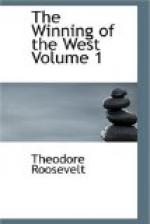The backwoodsmen of the Alleghanies felt that the quarrel was their own; in their hearts the desire for revenge burned like a sullen flame. The old men had passed their manhood with nerves tense from the strain of unending watchfulness, and souls embittered by terrible and repeated disasters; the young men had been cradled in stockaded forts, round which there prowled a foe whose comings and goings were unknown, and who was unseen till the moment when the weight of his hand was felt. They had been helpless to avenge their wrongs, and now that there was at last a chance to do so, they thronged eagerly to Lewis’ standard. The left wing or army assembled at the Great Levels of Greenbriar, and thither came the heroes of long rifle, tomahawk, and hunting-shirt, gathering from every stockaded hamlet, every lonely clearing and smoky hunter’s camp that lay along the ridges from whose hollows sprang the sources of the Eastern and the Western Waters. They were not uniformed, save that they all wore the garb of the frontier hunter; but most of them were armed with good rifles, and were skilful woodsmen, and though utterly undisciplined, they were magnificent individual fighters.[2] The officers were clad and armed almost precisely like the rank and file, save that some of them had long swords girded to their waist-belts; they carried rifles, for, where the result of the contest depended mainly on the personal prowess of the individual fighter, the leader was expected literally to stand in the forefront of the battle, and to inspirit his followers by deeds as well as words.
Among these troops was a company of rangers who came from the scattered wooden forts of the Watauga and the Nolichucky. Both Sevier and Robertson took part in this war, and though the former saw no fighting, the latter, who had the rank of sergeant, was more fortunate.
While the backwoods general was mustering his unruly and turbulent host of skilled riflemen, the English earl led his own levies, some fifteen hundred strong, to Fort Pitt.[3] Here he changed his plans, and decided not to try to join the other division, as he had agreed to do. This sudden abandonment of a scheme already agreed to and acted on by his colleague was certainly improper, and, indeed, none of the earl’s movements indicated very much military capacity. However, he descended the Ohio River with a flotilla of a hundred canoes, besides keel-boats and pirogues,[4] to the mouth of the Hockhocking, where he built and garrisoned a small stockade. Then he went up the Hockhocking to the falls, whence he marched to the Scioto, and there entrenched himself in a fortified camp, with breastworks of fallen trees, on the edge of the Pickaway plains, not far from the Indian town of Old Chillicothe. Thence he sent out detachments that destroyed certain of the hostile towns. He had with him as scouts many men famous in frontier story, among them George Rogers Clark, Cresap, and Simon Kenton—afterwards




